Moldova Nouă
|
Moldova Nouă Neumoldowa Újmoldova Nova Moldova / Нова Молдова Nová Moldava |
||||
|
||||
| Basic data | ||||
|---|---|---|---|---|
| State : |
|
|||
| Historical region : | Banat | |||
| Circle : | Caraș-Severin | |||
| Coordinates : | 44 ° 44 ' N , 21 ° 40' E | |||
| Time zone : | EET ( UTC +2) | |||
| Height : | 114 m | |||
| Area : | 146 km² | |||
| Residents : | 12,350 (October 20, 2011) | |||
| Population density : | 85 inhabitants per km² | |||
| Postal code : | 325500 | |||
| Telephone code : | (+40) 02 55 | |||
| License plate : | CS | |||
| Structure and administration (as of 2016) | ||||
| Community type : | city | |||
| Structure : | 3 districts / cadastral communities: Măcești , Moldova Veche , Moldovița | |||
| Mayor : | Torma Adrian Constantin ( PNL ) | |||
| Postal address : | Str. Nicolae Bălcescu, no. 26 loc. Moldova Nouă, jud. Caraș-Severin, RO-325500 |
|||
| Website : | ||||
Moldova Nouă ( ; German Neumoldowa , Hungarian Újmoldova , Czech Nová Moldava , Croatian Nova Moldova , Serbian - Cyrillic Нова Молдова ) is a town in Caraş-Severin County , Banat , Romania .
Geographical location
Moldova Nouă is located in the Banat on the south side of the Locva Mountains , a few kilometers to the left of the Danube . The district capital Reșița is about 65 km north.
Neighboring places
| Bela Crkva | Oravița | Târnova |
| Veliko Gradiste |

|
Orșova |
| Braničevo | Coronini | Sichevița |
history
The area of today's city originally consisted of two villages, namely Bosniak (first mentioned in 1723, originally inhabited by settlers from Styria and Tyrol) and Baron (1761, Romanian village). The current name has been documented since 1777. The history of the city is closely linked to mining, which was already in operation during the Roman Empire and resumed no later than 1728 - under the rule of Austria-Hungary . Since 1918 the place belongs to Romania. In 1968 it was named a city. The development of the actually central district of Moldova Nouă has stagnated in the last few decades, while the district of Moldova Veche on the Danube has expanded significantly through the port. Important branches of industry are fishing, shipping, wood processing and agriculture.
Copper mining has practically come to a standstill since 2005. The earth masses of the spoil heaps are insufficiently consolidated. The wind repeatedly transports toxic dust to Serbia , which repeatedly led to diplomatic tensions between the two countries.
population
In 1777 there were 32 houses in Moldova Nouă. In 1880, 3158 people lived in the actual place, of which 2586 Romanians , 421 Germans, 44 Serbs and 17 Hungarians . The population increased until 1966 (5838) and has been falling again since then. In the 2002 census, 3492 inhabitants were registered in the city proper, including 3314 Romanians, 67 Czechs , 49 Roma , 29 Serbs , 20 Hungarians and 10 Germans. In 2002, 13,917 people lived in the entire city.
traffic
Moldova Nouă has no rail connection. The Danube port in Moldova Veche is of great economic importance. National road 57 runs through the city from Orșova to Moravița . There are regular bus connections to Timișoara , Reșița and Caransebeș .
Attractions
- Valea Mare nature reserve in the Locva Mountains
- Iron Gate National Park
- Decebal Island in the Danube
- Cave Gaura cu Muscă
sons and daughters of the town
- Ella Zeller-Constantinescu (* 1933), table tennis player, four-time world champion
- Mihăiță Pleșan (* 1982), football player
- Anca Pop (1984-2018), Romanian-Canadian singer
- Raul Costin (* 1985), football player
- Iasmin Latovlevici (* 1986), football player
- Adrian Coriolan Gaspar (* 1987), Romanian-Austrian pianist, composer and arranger
Web links
Individual evidence
- ↑ 2011 census in Romania ( MS Excel ; 1.3 MB)
- ↑ Mayoral elections 2016 in Romania ( MS Excel ; 256 kB)
- ^ Website of the city, accessed on December 23, 2008 ( Memento from June 10, 2013 in the Internet Archive )
- ↑ ADZ.ro dated May 6, 2009, accessed on May 6, 2009 ( page no longer available , search in web archives ) Info: The link was automatically marked as defective. Please check the link according to the instructions and then remove this notice.
- ↑ 2002 census, accessed on December 23, 2008 (PDF; 858 kB)


